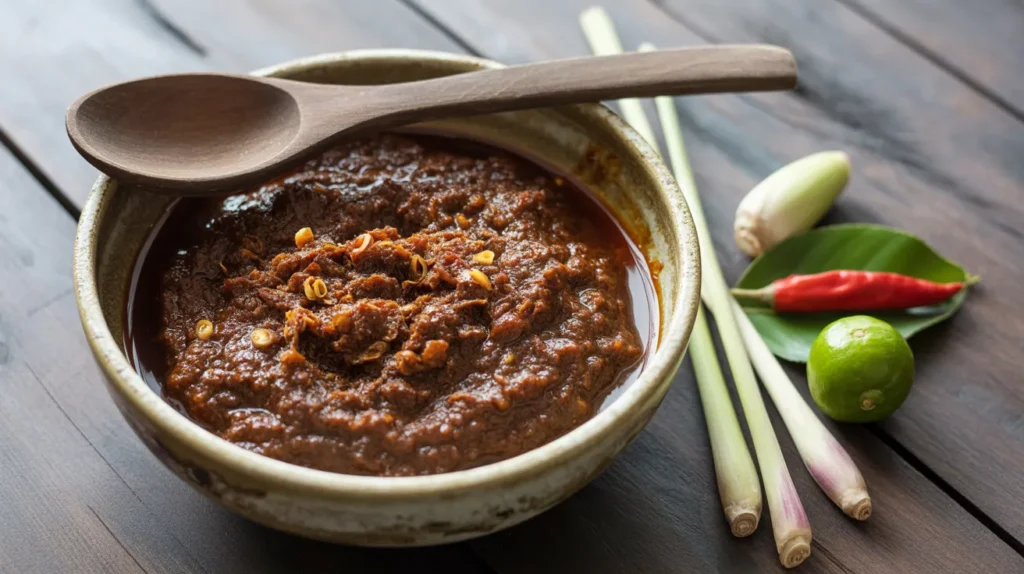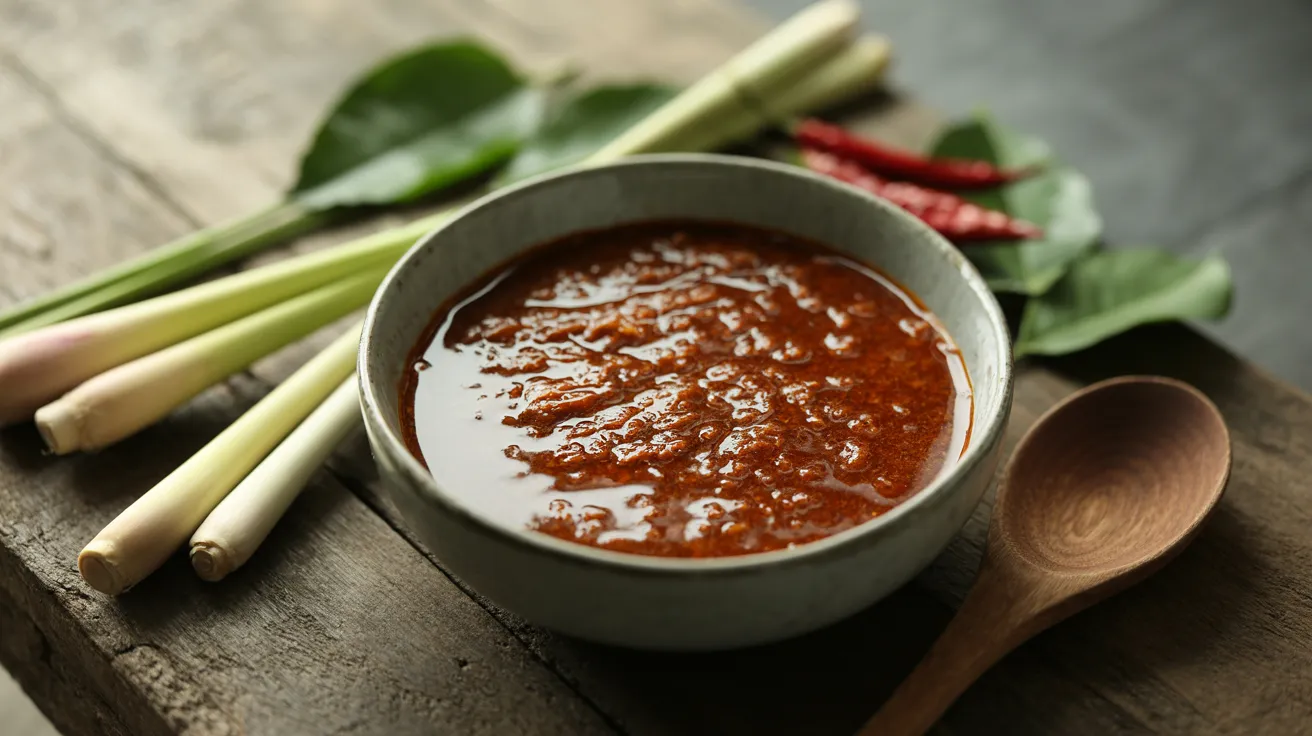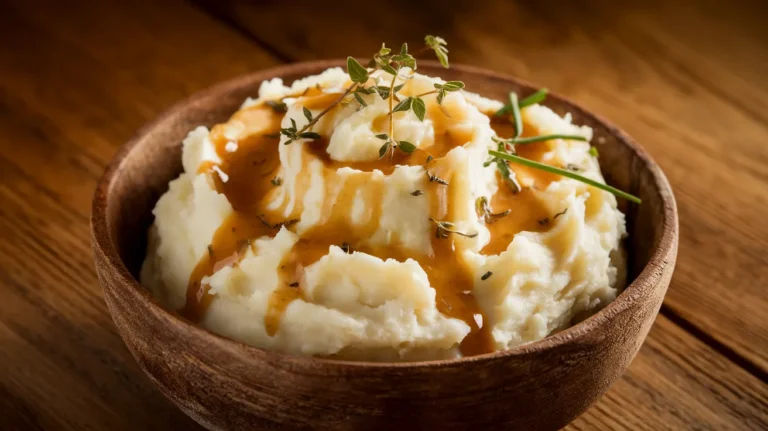- Rich, aromatic Rendang Sauce ready in just 15 minutes of active prep
- Perfect balance of lemongrass, galangal and toasted coconut flavors
- Freezer-friendly sauce that transforms any protein into a restaurant-quality meal
- Simplified technique that keeps authentic flavors without hours of simmering
Transform Your Home Cooking With Authentic Rendang Sauce
Ever tried to recreate that deep, complex Rendang Sauce at a restaurant and ended up with something that tasted… not quite right? You’re not alone.
Most home cooks struggle to capture the rich intensity of authentic Indonesian Rendang Sauce because they’re missing the crucial steps that develop those signature flavors.
But I’ve cracked the code on making restaurant-quality Rendang Sauce at home that’s foolproof, even for beginners. This recipe creates enough sauce for four generous servings, and you won’t believe how simple it can be.
The secret to perfect Rendang Sauce lies in two key techniques: properly toasting the spice paste and allowing enough time for the coconut milk to slowly reduce and intensify. With this recipe, you’ll master both.
Nutrition Breakdown Per Serving
| Nutrient | Amount | % Daily Value |
|---|---|---|
| Calories | 215 | – |
| Fat | 18g | 23% |
| Saturated Fat | 14g | 70% |
| Carbohydrates | 12g | 4% |
| Fiber | 3g | 12% |
| Protein | 3g | 6% |
| Sodium | 320mg | 14% |
| Potassium | 245mg | 7% |
| Iron | 2.5mg | 14% |
What You’ll Need For Perfect Rendang Sauce
Ingredients List
| Ingredient | Measurement | Notes |
|---|---|---|
| Dried chilies | 8 | Seeds removed |
| Lemongrass | 3 stalks | Bottom white part only, tough outer layers removed |
| Shallots | 6 medium | Peeled |
| Garlic | 5 cloves | Peeled |
| Ginger | 1-inch piece | Peeled |
| Galangal | 1-inch piece | Peeled (or substitute with more ginger) |
| Turmeric | 1-inch piece fresh or 1 tsp powder | Fresh preferred |
| Candlenuts | 4 | Can substitute with macadamia nuts |
| Coconut milk | 2 cups | Full-fat recommended |
| Coconut cream | ½ cup | For extra richness |
| Kaffir lime leaves | 4 | Fresh or dried |
| Tamarind paste | 1 Tbsp | For tangy note |
| Palm sugar | 2 Tbsp | Can substitute with brown sugar |
| Salt | 1 tsp | Adjust to taste |
| Vegetable oil | 3 Tbsp | For sautéing |
Kitchen Equipment
| Tool | Purpose |
|---|---|
| Food processor or blender | For creating the spice paste |
| Heavy-bottomed pot or Dutch oven | For cooking the sauce |
| Wooden spoon | For stirring |
| Measuring cups and spoons | For precise measurements |
| Sharp knife | For chopping ingredients |
| Cutting board | For preparing ingredients |
| Strainer | For draining soaked chilies |
| Small bowl | For soaking chilies |
| Medium bowl | For holding prepared spice paste |
| Tablespoon | For tasting and adjusting seasonings |
Ingredient Substitutions
- Galangal: Double the ginger if unavailable
- Candlenuts: Macadamia nuts or cashews work well
- Kaffir lime leaves: 1 tsp lime zest plus bay leaf
- Tamarind paste: 1 Tbsp lime juice plus 1 tsp brown sugar
- Palm sugar: Light brown sugar or coconut sugar
- Fresh turmeric: Ground turmeric (1 tsp)
If you’re a fan of Asian sauces, you might also enjoy making Hoisin Sauce at home, which shares some similar aromatics but with a completely different flavor profile.
Detailed Rendang Sauce Instructions For Beginners
Prep Time: 15 minutes
Cook Time: 60 minutes
Total Time: 75 minutes
Yield: 4 servings (approximately 2 cups of sauce)
1. Preparation Phase (15 minutes)
- Prepare your workspace
- Clear counter space for ingredient prep
- Set out all measuring cups and spoons
- Place cutting board and sharp knife in easy reach
- Have a small bowl ready for soaking chilies
- Set out medium bowl for holding spice paste once blended
- Prepare the dried chilies
- Examine dried chilies and discard any that show signs of mold
- Cut off the stems using kitchen shears or a knife
- Slice chilies lengthwise and remove all seeds (wear gloves to protect hands)
- Place seeded chilies in a small bowl
- Boil 1 cup of water in kettle or small pot
- Pour boiling water over chilies until completely submerged
- Set timer for 15 minutes to let chilies soften
- After soaking, drain chilies in a strainer (save 2 tablespoons of soaking liquid for later use)
- Gently press chilies against strainer to remove excess water
- Prepare the lemongrass
- Remove the tough outer layers of each stalk (peel off 2-3 layers)
- Cut off the dark green top portions (save for making broth if desired)
- Trim the root end of the stalks
- Using the back of a knife, bruise the white parts to release oils
- Cut into 1-inch pieces for easier blending
- Prepare other aromatics
- Peel shallots and cut into quarters
- Peel garlic cloves (smash with side of knife to make peeling easier)
- Peel ginger using the edge of a spoon (works better than a peeler)
- Cut ginger into thin slices
- Peel galangal (if using) and cut into thin slices
- If using fresh turmeric, peel and slice thinly (wear gloves as it stains)
- Fold kaffir lime leaves in half and tear out the tough center stem
2. Creating The Rendang Spice Paste (10 minutes)
- Blend the spice paste
- Add soaked chilies to food processor or blender
- Add prepared lemongrass pieces
- Add quartered shallots
- Add garlic cloves
- Add sliced ginger and galangal (if using)
- Add turmeric (fresh or powder)
- Add candlenuts (or substitute)
- Pulse 5-6 times to roughly chop all ingredients
- Scrape down sides of food processor with rubber spatula
- Add 2 tablespoons of reserved chili soaking liquid
- Process continuously for 1-2 minutes until smooth
- Check consistency – it should be smooth but thick, like peanut butter
- If too dry, add 1 tablespoon water at a time and pulse again
- Transfer finished paste to a bowl and set aside
3. Cooking The Rendang Sauce Base (15 minutes)
- Prepare your cooking area
- Place heavy-bottomed pot or Dutch oven on stove
- Turn on kitchen exhaust fan (the paste will be aromatic)
- Open windows if possible for ventilation
- Have wooden spoon ready for stirring
- Keep coconut milk and cream nearby
- Toast the spice paste
- Heat pot over medium heat for 2 minutes
- Add 3 tablespoons vegetable oil
- Wait until oil is shimmering but not smoking
- CAREFULLY add spice paste (stand back as it may splatter)
- Immediately reduce heat to medium-low
- Stir constantly for first 2 minutes to prevent burning
- Continue cooking for 8-10 minutes total, stirring every 30 seconds
- Watch for color change – paste will darken from bright orange-red to deeper brick red
- The oil will begin to separate from paste (this is good!)
- A proper toasted paste will smell fragrant, not raw
4. Developing The Rendang Sauce Flavors (50 minutes)
- Add liquids and aromatics
- Open coconut milk and cream cans and stir well (they often separate in the can)
- Slowly pour coconut milk into pot while stirring (helps prevent curdling)
- Add coconut cream and stir to incorporate
- Add the prepared kaffir lime leaves
- Stir everything together until well combined
- Bring mixture to a very gentle simmer (small bubbles at edge of pot)
- IMPORTANT: Do not allow to boil rapidly as this can cause coconut milk to separate
- Add flavorings and begin reduction
- Add tamarind paste, stirring until dissolved
- Add palm sugar (break into small pieces if it comes in a block)
- Stir until sugar is completely dissolved
- Reduce heat to lowest setting that maintains a gentle simmer
- Partially cover pot with lid (leaving about 1-inch gap)
- Set timer for 30 minutes
- Stir every 5-7 minutes to prevent sticking on the bottom
- Final reduction and seasoning
- After 30 minutes, remove lid completely
- Continue simmering for 15-20 more minutes
- Watch for visual cues: sauce will thicken and darken in color
- Oil should begin to separate and rise to surface (traditional characteristic)
- Test thickness by dipping wooden spoon – sauce should coat back of spoon
- Add 1 teaspoon salt
- Taste and adjust seasoning if needed (add more salt or palm sugar)
- Continue simmering 5 more minutes to incorporate seasoning
- Turn off heat and let stand 5 minutes before using or storing
For another complex Asian sauce with rich umami flavors, try making Tobanjan Sauce which works wonderfully in stir-fries and marinades.

Troubleshooting Your Rendang Sauce
| Problem | Cause | Solution |
|---|---|---|
| Sauce is too thin | Not simmered long enough | Continue simmering uncovered until reduced; add 1 tsp cornstarch mixed with water if needed |
| Sauce is too thick | Reduced too much | Add more coconut milk, 2 Tbsp at a time and stir gently to incorporate |
| Sauce is too spicy | Too many chilies or seeds not removed | Add more coconut milk and a bit more palm sugar to balance heat |
| Sauce is grainy | Spice paste not blended enough | Next time, blend longer; for now, strain through a fine mesh sieve while sauce is still hot |
| Sauce tastes bitter | Spice paste burned during cooking | Don’t cook paste on high heat; for now, add more palm sugar (1 Tbsp) and coconut milk (¼ cup) |
| Oil separation | Normal occurrence in traditional rendang | This is traditional and good! Stir back in before serving if desired |
| Sauce curdled | Coconut milk boiled at too high heat | Next time use lower heat; for now, blend small portions and stir back in |
| Sauce too sour | Too much tamarind | Add ½ Tbsp more palm sugar and a little more coconut milk |
| Lacks depth of flavor | Not enough toasting of spice paste | Add ¼ teaspoon ground coriander and cook 5 more minutes |
Variations & Substitutions For Rendang Sauce
Vegetarian Rendang Sauce
Use vegetables like jackfruit, tempeh, or firm tofu as your protein. Add an extra tablespoon of salt to compensate for the depth traditionally added by meat. Add 2 tablespoons of mushroom powder for umami flavor.
Quick Rendang Sauce (30-minute version)
In a time crunch? Use 3 tablespoons of pre-made red curry paste plus 1 tablespoon each of ground coriander and cumin to substitute for the fresh spice paste. Reduce coconut milk to 1 cup and simmer for just 20 minutes.
Extra Rich Rendang Sauce
Add ¼ cup of toasted desiccated coconut during the last 15 minutes of cooking for added texture and richness. Also add 1 cinnamon stick and 2 star anise during the simmering phase (remove before serving).
Mild Rendang Sauce
Reduce dried chilies to 3-4 and remove all seeds. Add a red bell pepper to the spice paste for color without heat. Increase palm sugar to 3 tablespoons to balance flavors.
Storage & Reheating Your Rendang Sauce
Refrigerator Storage
- Let sauce cool completely to room temperature (no more than 2 hours)
- Transfer to clean glass jars or containers with tight-fitting lids
- Store in refrigerator for up to 5 days
- The flavor actually improves after 24 hours in the refrigerator
Freezer Storage
- Cool sauce completely
- Portion into freezer-safe containers (leaving ½-inch headspace for expansion)
- Alternatively, freeze in ice cube trays, then transfer frozen cubes to freezer bags
- Label containers with “Rendang Sauce” plus the date
- Keeps for up to 3 months in freezer
- Thaw overnight in refrigerator before using
Reheating Instructions
- Thaw overnight in refrigerator if frozen
- Transfer sauce to a small saucepan
- Reheat over low heat, stirring frequently
- Add 1-2 tablespoons of water or coconut milk if sauce is too thick
- Heat until just simmering (avoid boiling)
- If sauce has separated, stir gently to recombine
- Use immediately after reheating
Safety Notes & Tips For Perfect Rendang Sauce
Safety Considerations
- Heat management: Always cook spice paste on medium-low heat to prevent burning and bitter flavors
- Oil splatters: Stand back when adding paste to hot oil to avoid burns
- Ventilation: Ensure good kitchen ventilation as the aromatics can be strong and may irritate eyes
- Food safety: Don’t leave finished sauce at room temperature for more than 2 hours
- Storage containers: Use glass containers rather than plastic to prevent staining
- Hand protection: Consider wearing gloves when handling chilies to prevent skin irritation
Beginner Tips
- Prep everything first: Have all ingredients measured and prepped before starting cooking
- Don’t rush the process: The flavor develops during the slow cooking process
- Watch heat levels: Low and slow is the key to perfect Rendang Sauce
- Taste as you go: Adjust seasoning gradually, especially salt and sugar
- Color guide: The sauce should progress from bright orange-red to deep reddish-brown
- Texture guide: Final sauce should coat the back of a spoon but still be pourable
If you want to explore more complex flavors, Tandoori Sauce makes a great addition to your homemade sauce collection with its distinctive spice profile.
Pro Tips For Perfect Rendang Sauce
- Toast whole spices: For deeper flavor, dry toast 1 tablespoon each of coriander and cumin seeds before grinding and adding to the paste
- Don’t rush the process: The longer, slower simmer develops the complex flavors that make Rendang Sauce special
- Make it ahead: Prepare your Rendang Sauce a day ahead for best results as flavors meld and intensify overnight
- Sauce consistency guide: Traditional rendang has a thick, almost dry consistency – don’t worry if most liquid evaporates
- Quality matters: Use fresh spices and full-fat coconut milk for best results
- Freezer prep: Make double batch and freeze half for quick future meals
- Aromatics shortcut: If you have a mortar and pestle, pound the lemongrass first before adding to the food processor for better extraction of flavors
Serving Suggestions For Your Rendang Sauce
- Add to slow-cooked beef for traditional beef rendang
- Combine with chicken thighs for a quicker cooking option
- Simmer with lamb shoulder for rich depth of flavor
- Stir through jackfruit for a vegetarian option
- Serve with steamed jasmine rice and simple cucumber salad
- Add a spoonful to fried rice for instant flavor upgrade
- Use as a flavor base for vegetable stews
- Toss with roasted vegetables for a flavor-packed side dish
- Mix a spoonful into mayonnaise for an exotic sandwich spread
- Use as a marinade for grilled meats (thin with a little oil)
Now you have all the knowledge to create authentic Rendang Sauce at home that rivals any restaurant version!




